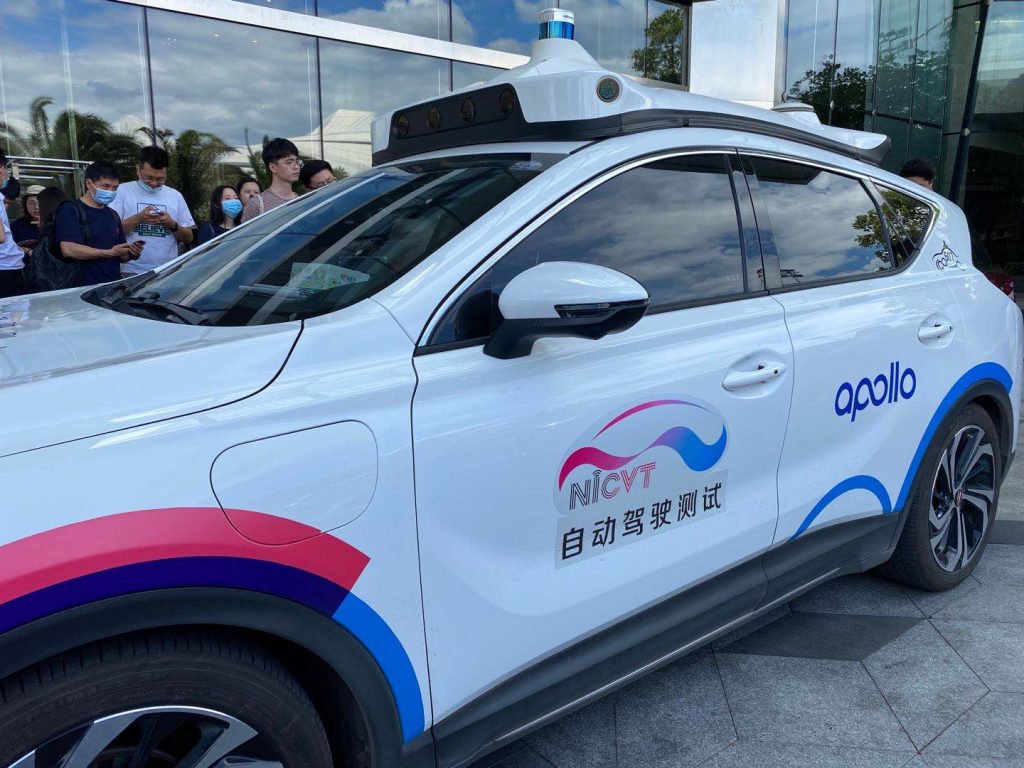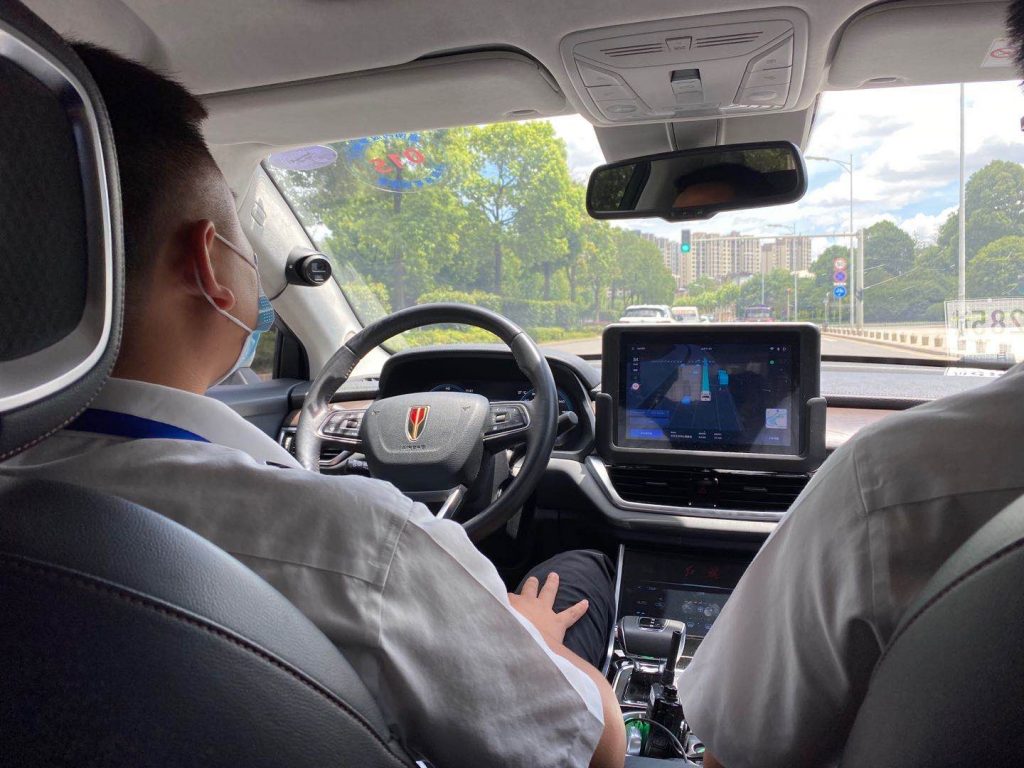On the roads of Changsha, the capital of south-central Hunan province, for the first time, I was sitting in the backseat of a self-driving car, watching the steering wheel turn left and right all by itself, like a robotic arm.
It was a ride provided by Baidu’s Apollo, the self-driving unit of a firm otherwise famous for being China’s answer to Google search. It is not complicated to hail a Baidu robotaxi as long as you are in an area where these vehicles are licensed to run, as getting a ride only requires a few taps on the Baidu Maps app.
Currently, the Apollo vehicle only allows up to two passengers at once, while customers need to wait at selected pickup spots and can get out at certain destinations points. Just a few minutes after my booking, a white FAW Hongqi electric vehicle (EV) with “Apollo” printed on the door and sensors on top came to pick me. However, a man wearing a white shirt got out of the car.
He was the “navigator,” who sits in the co-driver seat as required, while there was another man sitting in the driver’s seat. Well, maybe the driverless experience doesn’t look that different than a normal ride-hailing ride, I thought to myself.
After checking my temperature, as a measure against the COVID-19 pandemic, and scanning a QR code on an infotainment screen, I was ready for my first robotaxi ride.
Slowly, the EV started to drive forward on the main road between other ordinary vehicles. The “security driver” put his hands on his legs, to ensure that he was not intervening. The road had a speed limit of 50 kilometers per hour (km/h) and the Apollo vehicle drove at around 40 km/h. On the infotainment screen, passengers can check the speed, play music, adjust the car’s temperature, and see the map with a visualization of the objects on the road.

The “navigator” assistant, sitting on the left front seat, told me that there are 45 Apollo vehicles running in the Xiangjiang New District in Changsha, in an area of approximately 130 square kilometers. The driving routes cover some of Changsha’s residential areas, commercial areas, industrial parks, and other popular locations. My robotaxi ride lasted more than 10 km.
Baidu’s robotaxi trial opened to the public in April and is available at no charge to users who are between the ages of 18 and 65 years old. When there are no requests for rides, the system will automatically assign cars to run without passengers —but with a security driver on board— to collect more data.
Overall, my first robotaxi experience felt amazing and safe, thanks to the sunny weather, and the security driver who kept an eye on the road. Human assistance is still required when the weather is bad or when the cars drive out of the designated regions.
However, Chen Zhihui, a Changsha resident who tried Apollo after getting to know the service from a local WeChat public account, told me that his expectations were higher, “The car braked hard when another car came across the street. And it’s not smart enough to shift between lanes,” he said. “It will take time for the system to know the road conditions very well.”

Different paths
Search giant Baidu has been committing resources to its AI and advanced self-driving car technology in recent years, in a bid to claw its way back as its search business has lost its luster in the era of mobile internet, when netizens spend more time on apps like WeChat and Douyin.
Baidu’s Apollo project began in 2013 and has already seen some progress. In the California Department of Motor Vehicles (DMV)’s 2019 disengagement report (Disengagements are those conditions where the security driver takes control of the vehicle) an annual survey that requires all licensed companies to test autonomous cars on California’s public roads, Apollo ranked first among 60 companies that submitted their data.
In March 2020, research firm Navigant Research ranked Baidu Apollo as one of the four “leaders” across the world in the autonomous driving field, together with Google parent Alphabet’s Waymo, General Motors’ Super Cruise, and Ford autonomous vehicle division. However, many players are vying for a stake in the self-driving sector, including large internet companies, traditional automakers, electric vehicle producers, and startups.
In China, local competitors are ride-hailing giant Didi, AutoX, WeRide, Huawei, and Nio, among others.
Robotaxis providers like Waymo and Baidu claim to have achieved Level 4 autonomous driving capabilities, which means that vehicles are fully autonomous and can handle the majority of driving situations independently, except for some extreme weather conditions, as stipulated by SAE International, the association which sets the international framework for the self-driving sector. Level 3 is called “conditional automation”, which means the driver needs to take over in some circumstances, while the faraway Level 5 doesn’t require human intervention at all.
“In essence, autonomous driving is more like an ‘advanced driving assistance function’ that gets mature over time, rather than an innovation that could change the whole picture of how people drive overnight,” said Zhang Weixing, a machine learning engineer who works for Comma.ai, a US-based self-driving startup.
To develop better self-driving capabilities, players have picked different paths. “Generally, self-driving companies fall into two categories: One is firms that will be selling self-driving as a service, typically in the form of robotaxi, like Waymo, Baidu, and Didi. The other is companies selling self-driving solutions with their vehicles or to other automakers, like Tesla and Mobileye. In this scenario, consumers own the car and the technology,” Zhang said.
In Zhang’s view, in the near future, robotaxis services would not be more cost-effective or more reliable than today’s regular taxis, because the technology still needs time to mature. Scaling up fleets and collecting data are also costly especially with a centralized scheme, he explained.
Li Zhenyu, Baidu’s corporate vice-president and general manager of Apollo, also recognized difficulties in popularizing this service. It is like “climbing the Everest and laying eggs along the way,” he wrote about the commercialization of Apollo in an internal letter this year. Li added that Baidu will introduce various services little by little, such as self-driving solutions in closed areas, self-parking systems, and autonomous delivery minivans.
National policies supporting a self-driving future
Changsha is not the only Chinese city where citizens have the chance to try self-driving taxis.
In Shanghai, Didi launched the trial of its own service on designated test roads earlier in June, while smart mobility startup WeRide operates a fleet of autonomous robotaxis in the southern city of Guangzhou. The service is available in a public area that stretches 144 square kilometers, via WeRide’s app and also Alibaba’s AutoNavi app known as Gaode Map, since June. Tests are also ongoing in other cities, including the capital Beijing, Cangzhou, Chongqing, and Wuhan.
The development of autonomous cars doesn’t only benefit these enterprises but also became part of China’s plan to become a tech leader across the world, as the country is ramping up “new infrastructure” projects encompassing 5G networks, artificial intelligence, industrial internet, self-driving, the Internet of Things, and others.
The nation’s push to foment a technology-driven economy is expected to speed up the rollout of self-driving cars, with a focus on “vehicle-to-everything” (V2X), a technology integrating intelligent vehicles and intelligent roads, connecting cars to network-connected roadside devices.
“If the central government in China issues a general policy about road tests of driverless vehicles, local authorities will respond to the policy very quickly,” Jewel Li, AutoX’s chief operating officer told KrASIA in an interview in April.
On August 21, Baidu expanded the Apollo robotaxi service in Cangzhou, a city located within the Beijing-Tianjin-Hebei region. Pickup and drop-off stations cover train stations, schools, hotels, industrial areas, and other public spaces. Supported by the local government, Baidu Apollo’s fleet began testing its services in September 2019, after establishing a strategic cooperation agreement with Cangzhou, which opened certain road networks for manned autonomous driving testing.
However, seeing through the hope and hype around the self-driving sector, it’s undeniable that the technology still needs time to reach an inflection point of widespread adoption and commercialization.
Update August 24: The story has been updated to reflect Baidu’s robotaxi expansion in Cangzhou, Hebei region.

